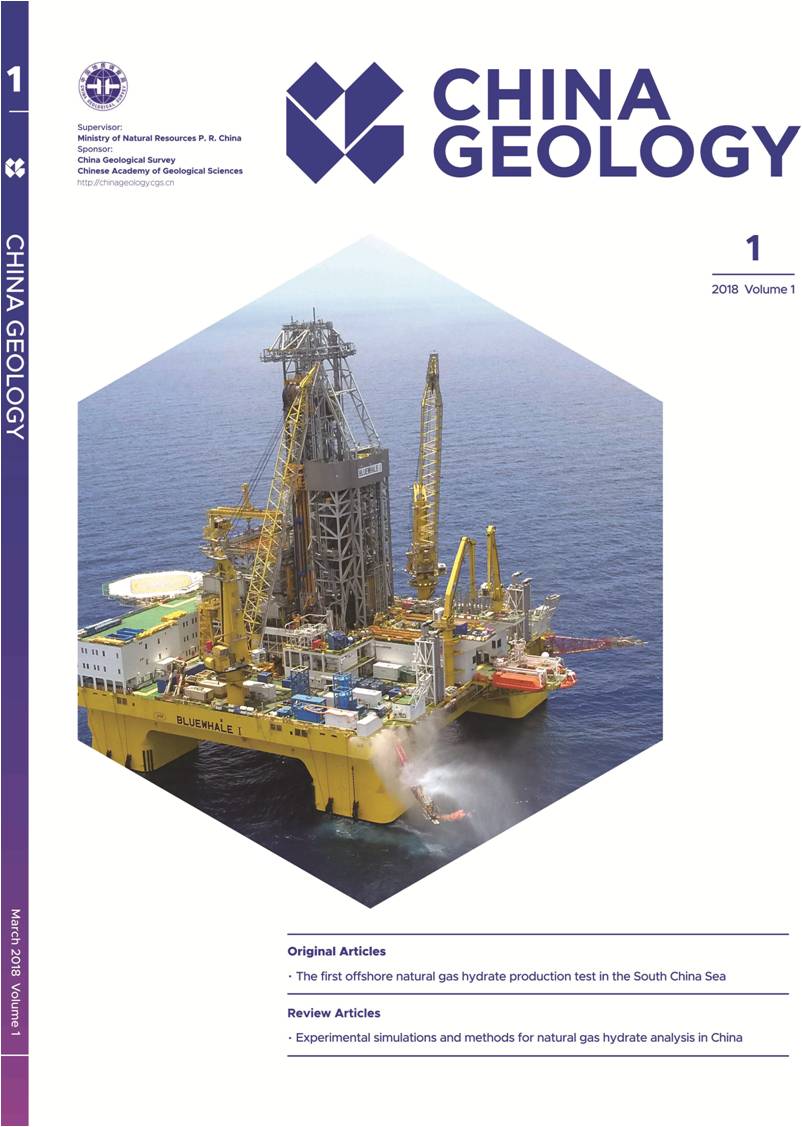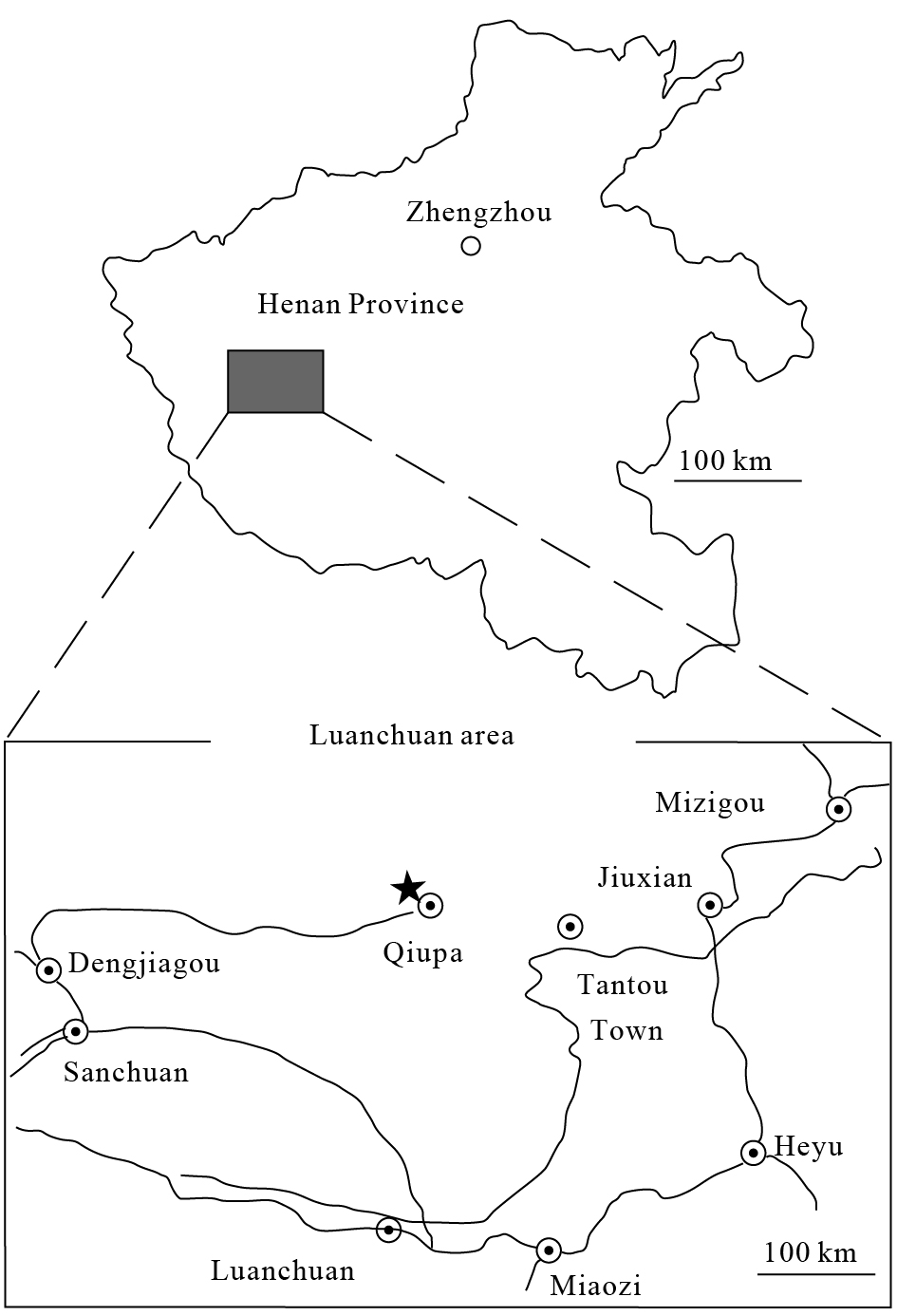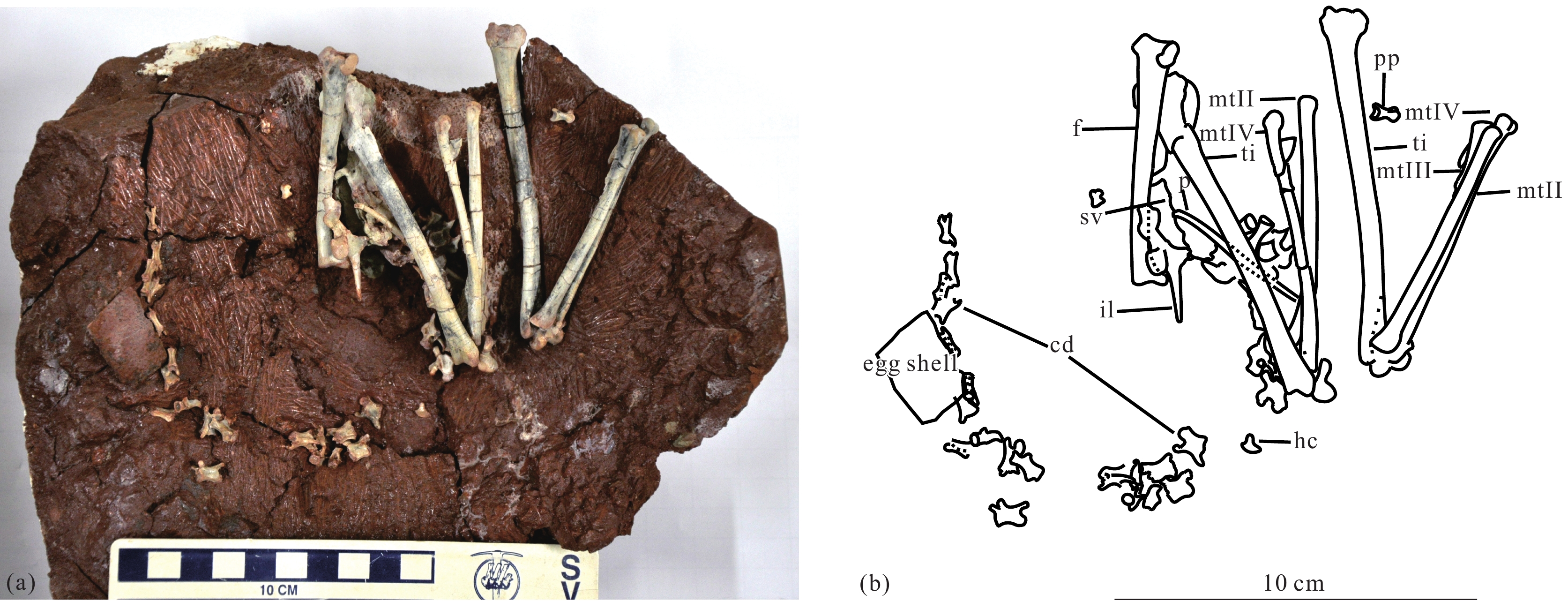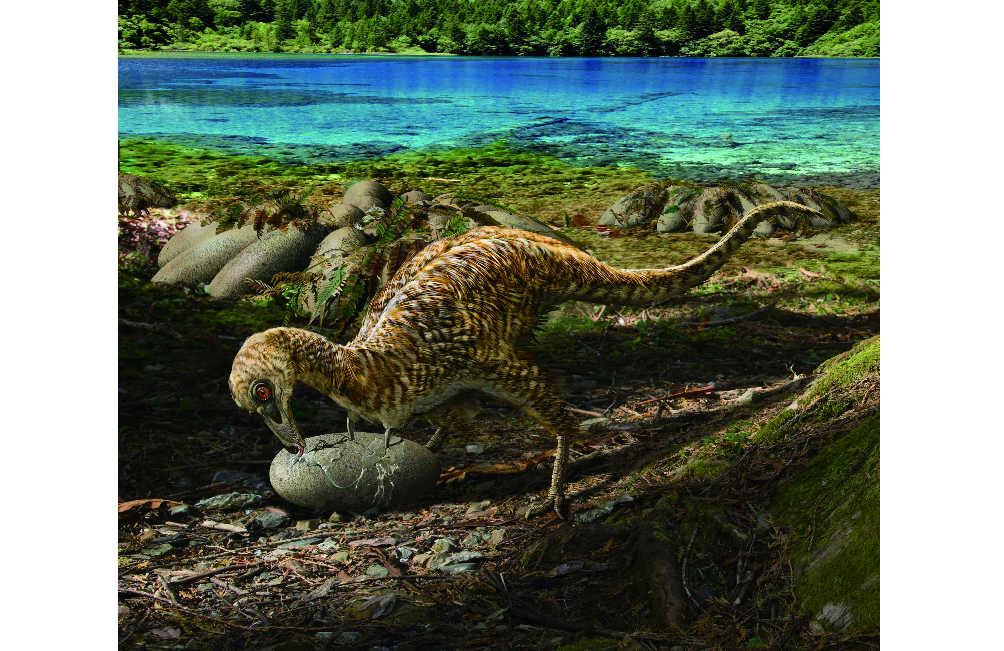| Citation: | Jun-chang Lü, Li Xu, Hua-li Chang, Song-hai Jia, Ji-ming Zhang, Dian-song Gao, Yi-yang Zhang, Cheng-jun Zhang, Fang Ding, 2018. A new alvarezsaurid dinosaur from the Late Cretaceous Qiupa Formation of Luanchuan, Henan Province, central China, China Geology, 1, 28-35. doi: 10.31035/cg2018005 |
A new alvarezsaurid dinosaur from the Late Cretaceous Qiupa Formation of Luanchuan, Henan Province, central China
-
Abstract
An alvarezsaurid dinosaur skeleton was discovered from the Late Cretaceous Qiupa Formation of Luanchuan, Henan Province of centtral China. It represents a new alvarezsaurid dinosaur Qiupanykus zhangi gen. et sp. nov. A phylogenetic analysis recovers Qiupanykus nested within the unresolved clade, which includes Asian and north American taxa. The skeleton of the new specimen is preserved in association with eggshells. The eggshell morphologies show that these eggs belong to oviraptorid eggs, skeletal remains of which were discovered from the same area. The alvarezsaurid skeleton associated with eggshell fragments may indicate that these eggs were broken by the strong thumb-claws of the former and that alvarezsaurid dinosaurs may be egg-eaters.
-
Keywords:
- Vertebrate paleontology /
- alvarezsaurid dinosaur /
- Qiupanykus /
- Late Cretaceous /
- central China
-

-
References
[1] Agnolin FL, Powell JE, Novas FE, Kundrát M. 2012: New alvarezsaurid (Dinosauria, Theropoda) from uppermost Cretaceous of north-western Patagonia with associated eggs. Cretaceous Research. 35, 33-56. [2] Averianov A, Sues H-D.2017. The oldest record of Alvarezsauridae (Dinosauria: Theropoda) in the Northern Hemisphere. PLoS ONE 12(10): e0186254. https://doi.org/10.1371/journal. pone.0186254 doi: 10.1371/journal.pone.0186254 [3] Alifanov VR, Barsbold R. 2009. Ceratonykus oculatus gen. et sp. nov., a new dinosaur (Theropoda, Alvarezsauria) from the Late Cretaceous of Mongolia. Paleontologicheskii Zhurnal (Russ.). 1, 86-99. [4] Averianov A, Sues H-D. 2017. The oldest record of Alvarezsauridae (Dinosauria: Theropoda) in the Northern Hemisphere. PLoS ONE 12(10): e0186254. https://doi.org/10.1371/journal.pone.0186254 doi: 10.1371/journal.pone.0186254 [5] Bonaparte, J.F. 1991. Los vertebrados fosiles de la formacion Rio Colorado, de la ciudad de Neuquen y Cercanias, Creatcio Superior, Argentina. Rev. Mus. Agent. Cienc. Bernadino Rivadavia, Paleontol. 4: 16-123. [6] Bureau of Geology and Mineral Resources of Henan Province.1989. Regional Geology of Henan Province. Geological Publishing House, Beijing, 1–772. [7] Campione N.E., EvansD.C., Caleb M. BrownC.M., Matthew T. Carrano M.T. 2014. Body mass estimation in non-avian bipeds using a theoretical conversion to quadruped stylopodial proportions. Methods in Ecology and Evolution, 5 : 913-923 [8] Chiappe L. M., Norell M. A. and Clark J. M.1996. Phylogenetic position of Mononykus (Aves: Alvarezsauridae) from the Cretaceous of the Gobi desert. Memoirs of the Queensland Museum 39(3): 557-582. [9] Chiappe L. M., Norell M. A. and Clark J. M. 1998. The skull of a relative of the stem-group bird Mononykus. Nature 392: 275-278. [10] Chiappe LM, Norell MA, Clark JM. 2002. The Cretaceous, short-armed Alvarezsauridae: Mononykus and its kin. In: Chiappe, L.M., Witmer, L.M. (Eds.), Mesozoic Birds: Above the Heads of Dinosaurs. University of California Press, Berkeley, 87-120. [11] Choiniere, J.N., Xu, X., Clark, J.M., Forster, C.A., Guo, Y. and Han, F. 2010. A basal alvarezsauroid theropod from the early Late Jurassic of Xinjiang, China. Science, 327: 571-574. [12] Gauthier JA. 1986. Saurischian monophyly and the origin of birds. In: Padian, K.(ed.), The Origin of Birds and the Evolution of Flight. Memoirs of the California Academy of Sciences, 8, 1-55. [13] Goloboff, P. A., Farris, J. S., Nixon, K. C. 2008. TNT. A free program for phylogenetic analysis. Cladistics 24, 774–786. [14] Hutchinson J. and Chiappe L. 1998. The first known alvarezsaurid (Theropoda: Aves) from North America. Journal of Vertebrate Paleontology. 18(3), 447-450. [15] Jiang XJ, Liu YQ, Ji SA. 2011. Dinosaur-bearing strata and K/T boundary in the Luanchuan-Tantou Basin of western Henan Province, China. Science China: Earth Science, 54, doi: 10.1007/s11430-011-4186-1. [16] Karhu A.A., Rautian, A.S., 1996. A new family of Maniraptora (Dinosauria: Saurischia) from the Late Cretaceous of Mongolia. Paleontological Journal 30: 583-592. [17] Kundrát M, Lü JC, Xu L, Pu HY, Shen CZ, Chang HL. 2017. First assemblage of eggshells and skeletal remains of the alvarezsaurid dinosaur from Laurasia (Upper Cretaceous, China). Journal of Vertebrate Paleontology abstracts, 145. [18] Lü JC, Xu Li, Zhang XL, Ji Q, Jia SH, Hu WY, Zhang JM, Wu YH. 2007. New dromaesoaurid dinosaur from the Late Cretaceous Qiupa Formation of Luanchuan area, western Henan, China. Geological Bulletin of China, 26 (7), 777-786. [19] Lü JC, Xu Li, Pu HY, Chang HL. 2012. New alvarezsaurid (Dinosauria, Theropoda) from uppermost Cretaceous of Luanchuan, Henan Province of China. Journal of Vertebrate Paleontology abstracts, 130. [20] Longrich N. R. and Currie, P. J. 2009. Albertonykus borealis, a new alvarezsaur (Dinosauria: Theropoda) from the Early Maastrichtian of Alberta, Canada: Implications for the systematics and ecology of the Alvarezsauridae. Cretaceous Research 30 (1): 239-252. [21] Martinelli, A. G., Vera, E.I. 2007. Achillesaurus manazzonei, a new alvarezsaurid theropod (Dinosauria) from the Late Cretaceous Bajo de la Carpa Formation, Río Negro Province, Argentina. Zootaxa. 1582: 1-17. [22] Naish, D., Dyke, G.D., 2004. Heptasteornis was no ornithomimid, troodontid, dromaeosaurid or owl: the first alvarezsaurid (Dinosauria: Theropoda) from Europe. Neues Jahrbuch für Geologie und Paläontologie 7: 385e401. [23] Nesbitt S.J., Clarke, J.A., Turner, A.H., Norell, M.A. 2011. A small alvarezsauroid from eastern Gobi Desert offers insight into evolutionary patterns in the Alvarezsauroidea. Journal of Vertebrate Paleontology. 31(1): 144-153. [24] Novas F.E. 1996. Alvarezsauridae, Cretaceous maniraptorans from Patagonia and Mongolia. Memoirs of the Queensland Museum 39: 675-702 [25] Novas, F. E. 1997. Anatomy of Patagonykus puertai (Theropoda, Avialae, Alvarezsauridae), from the Late Cretaceous of Patagonia. Journal of Vertebrate Paleontology 17(1); 137-166. [26] Perle A., L. M. Chiappe, Barsbold, R., J. Clark and M. A. Norell 1994. Skeletal Morphology of Mononykus olecranus (Theropoda: Avialae) from the Late Cretaceous of Mongolia. American Museum Novitates 3105: 1-29. [27] Perle A., Norell M. A., Chiappe, L. M., Clark, J. M. 1993. Flightless bird from the Cretaceous of Mongolia. Nature 362: 623-626. [28] Senter P. 2005. Function in the stunted forelimbs of Mononykus olecranus (Theropoda), a dinosaurian anteater. Paleobiology, 31: 373-381. [29] Suzuki SL, Chiappe G, Dyke M, Watabe RB,Tsogtbaatar K. 2002. A new specimen of Shuvuuia deserti Chiappe, 1998, from the Mongolian Late Cretaceous with a discussion of the relationships of alvarezsaurids to other theropod dinosaurs.Contributions in Science (Los Angeles), 494, 1-18. [30] Tanaka K., Lü J.C., Kobayashi K., Zelenisky D., Xu L., Jia S. H., Qin S. and Tang M. 2011. Description and phylogenetic position of dinosaur eggshells from the Luanchuan area of western Henan Province, China. Acta Geologica Sinica 85 (1): 66-74. [31] Tanaka K., Zelenitsky D. K., Saegusa H., Ikeda T., DeBuhr C.L., Therrien F. 2016. Dinosaur eggshell assemblage from Japan reveals unknown diversity of small theropods. Cretaceous Research, 57: 350-363 [32] Xu X, Wand DY, Sullivan C, Hone DWE, Han FL, Yan RH, Du FM. 2010. A basal parvicursorine (Theropoda: Alvarezsauridae) from the Upper Cretaceous of China. Zootaxa, 2413, 1-19. [33] Xu X., Sullivan, C., Pittman, M., Choiniere, J. N., Hone, D. W.E.,Upchurch, P., Tan, Q.W., Dong X., Tan L., and Han F.L. 2011. A monodactyl nonavian dinosaur and the complex evolution of the alvarezsauroid hand. Proceedings of the National Academy of Sciences 108 (6): 2338-2342. -
Access History

-
Figure 1.
Map of the holotype locality in Luanchuan of Henan Province, China. The star represents the fossil site.
-
Figure 2.
The photograph (a) and outline drawings (b) of Qiupanykus zhangi: Abbreviations: cd: caudal vertebrae; f: femur; hc: haemal arch; il: ilium; mt(II-IV): metatarsls II-IV; ti: tibia; p: pubis; pp: pedal phalanx; sv: sacral vertebrae.
-
Figure 3.
The strict consensus of the 20 most parsimonious trees, showing the systematic position of Qiupanykus among alvarezsaurid dinosaurs.
-
Figure 4.
Life scene of Qiupanykus zhangi (drawn by Zhao Chuang).





 DownLoad:
DownLoad:


